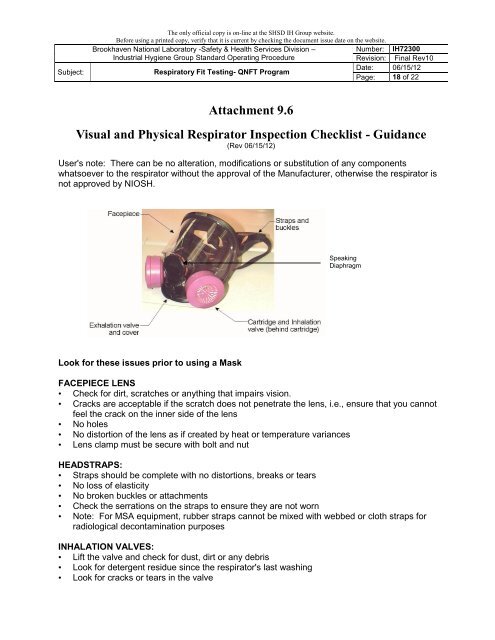IH72300 Respiratory Fit Testing- QNFT Program - Brookhaven ...
IH72300 Respiratory Fit Testing- QNFT Program - Brookhaven ...
IH72300 Respiratory Fit Testing- QNFT Program - Brookhaven ...
Create successful ePaper yourself
Turn your PDF publications into a flip-book with our unique Google optimized e-Paper software.
The only official copy is on-line at the SHSD IH Group website.<br />
Before using a printed copy, verify that it is current by checking the document issue date on the website.<br />
<strong>Brookhaven</strong> National Laboratory -Safety & Health Services Division –<br />
Number: <strong>IH72300</strong><br />
Industrial Hygiene Group Standard Operating Procedure<br />
Revision: Final Rev10<br />
Subject: <strong>Respiratory</strong> <strong>Fit</strong> <strong>Testing</strong>- <strong>QNFT</strong> <strong>Program</strong><br />
Date:<br />
Page:<br />
06/15/12<br />
18 of 22<br />
Attachment 9.6<br />
Visual and Physical Respirator Inspection Checklist - Guidance<br />
(Rev 06/15/12)<br />
User's note: There can be no alteration, modifications or substitution of any components<br />
whatsoever to the respirator without the approval of the Manufacturer, otherwise the respirator is<br />
not approved by NIOSH.<br />
Look for these issues prior to using a Mask<br />
FACEPIECE LENS<br />
• Check for dirt, scratches or anything that impairs vision.<br />
• Cracks are acceptable if the scratch does not penetrate the lens, i.e., ensure that you cannot<br />
feel the crack on the inner side of the lens<br />
• No holes<br />
• No distortion of the lens as if created by heat or temperature variances<br />
• Lens clamp must be secure with bolt and nut<br />
HEADSTRAPS:<br />
• Straps should be complete with no distortions, breaks or tears<br />
• No loss of elasticity<br />
• No broken buckles or attachments<br />
• Check the serrations on the straps to ensure they are not worn<br />
• Note: For MSA equipment, rubber straps cannot be mixed with webbed or cloth straps for<br />
radiological decontamination purposes<br />
INHALATION VALVES:<br />
• Lift the valve and check for dust, dirt or any debris<br />
• Look for detergent residue since the respirator's last washing<br />
• Look for cracks or tears in the valve<br />
Speaking<br />
Diaphragm
















